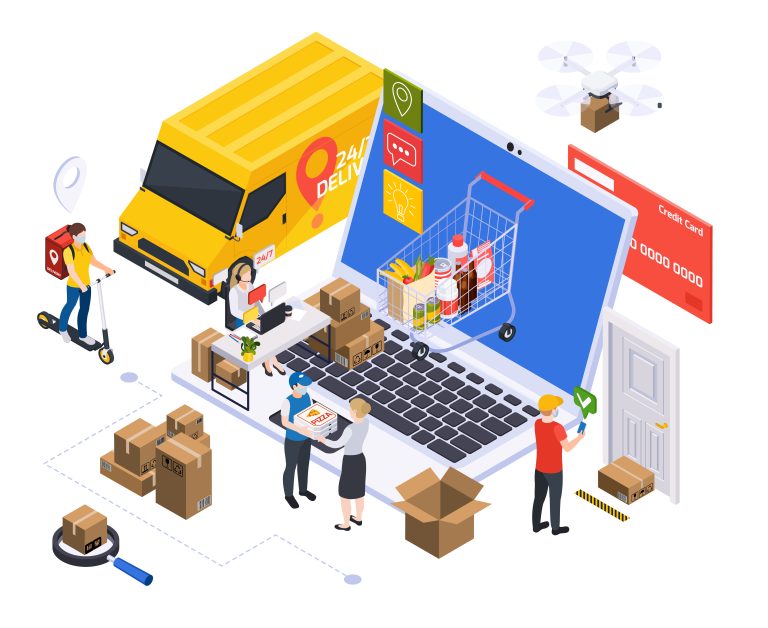
What is E-commerce Logistics?
E-commerce logistics is the process of delivering products from the manufacturer or storage to the customer’s home. It’s a crucial part of online businesses and can impact customer satisfaction. In this guide, we will explain e-commerce logistics in simple terms and provide step-by-step strategies to help you optimize your business operations. Whether you’re an experienced e-commerce entrepreneur or just starting out, this guide will help you master e-commerce logistics.
E-commerce Logistics Flow Process
E-commerce logistics refers to the management and coordination of the various processes involved in the storage, transportation, and delivery of products sold through online platforms. It encompasses a wide range of activities, from warehousing and inventory management to order processing and last-mile delivery. To truly understand e-commerce logistics, it’s essential to break it down into its key components.
- Warehousing and Inventory Management
Warehousing is the heart of e-commerce logistics. It involves the storage of products before they are shipped to customers. Efficient warehousing is crucial for ensuring that products are readily available when customers place their orders. Proper inventory management, including stock levels, organization, and tracking, is essential to prevent stockouts and overstock situations.
- Order Processing
The flow process directly impacts customer satisfaction in e-commerce. Delays in order processing or shipping can lead to frustrated customers who may choose to shop elsewhere in the future. By understanding the flow process and taking steps to improve efficiency, businesses can ensure timely delivery, accurate order fulfillment, and effective customer communication.
- Transportation and Shipping
Once products are ready for shipment, choosing the right transportation method is critical. E-commerce businesses often rely on a combination of shipping carriers, including national and international options, to ensure timely and cost-effective delivery. Shipping costs, delivery times, and tracking capabilities all play a role in the decision-making process.
- Last-Mile Delivery
The last mile refers to the final stage of the delivery journey, where products are transported from a local distribution center to the customer’s doorstep. Collaborating with reliable last-mile delivery partners can significantly enhance order fulfillment. Businesses should consider working with third-party logistics providers or courier services that offer fast and reliable delivery options, package tracking, and flexible delivery time slots.
Challenges in E-commerce Logistics
While e-commerce logistics offers immense opportunities, it also comes with its fair share of challenges. Understanding these challenges is crucial for designing effective solutions
- Inventory Management Complexity
Maintaining accurate inventory records is essential to ensure efficient order fulfillment. Businesses should utilize inventory management software or systems that enable real-time tracking of stock levels, sales, and customer orders. This helps prevent overselling, backorders, and stockouts, which can lead to dissatisfied customers.
- Customer Expectations
Once the customer places an order, they expect fast deliveries and real-time tracking. Businesses must meet the delivery deadline to meet customers’ expectations. Meeting these high expectations requires innovative solutions and a robust logistics infrastructure.
- Returns and Reverse Logistics
Accepting parcels at the time of delivery or returning a product is quite normal in e-commerce. Managing returns is crucial for smooth operations and customer satisfaction. Having an efficient reverse logistics system in place ensures that returns are processed effectively.
Reverse logistics involves inspecting returned items, deciding whether they can be restocked or need to be disposed of, and ensuring that customers receive refunds or replacements promptly.
Strategies for E-commerce Logistics Success
To outrank your competitors in the world of logistics, you need to adopt strategies that optimize every aspect of the logistics process.
- Embrace Technology
Invest in state-of-the-art inventory management and order processing systems. Automation and data analytics can significantly enhance efficiency and accuracy.
- Optimize Warehousing
Maximize the use of your warehouse space by implementing efficient storage solutions. Consider the use of vertical shelving and automation to reduce overheads.
- Choose the Right Shipping Partners
Partner with shipping carriers that offer competitive rates and reliable service. Negotiate shipping contracts to secure favorable terms for your business.
- Last-Mile Innovation
Invest in last-mile delivery solutions such as route optimization software and local delivery partnerships to provide fast and reliable delivery options to your customers.
- Sustainability Initiatives
Consider eco-friendly packaging and shipping options. Consumers increasingly value businesses that prioritize sustainability.
Conclusion
In the ever-evolving landscape of e-commerce, mastering the flow process of logistics is essential for staying competitive and ensuring customer satisfaction. By optimizing warehousing, embracing technology, and choosing the right partners, you can set your e-commerce business on a path to success.
Remember, e-commerce logistics is not just about moving products—it’s about delivering exceptional customer experiences. As you implement these strategies, you’ll not only stay ahead of your competitors but also earn the loyalty of your customers, propelling your business to new heights. For those requiring hassle-free large item delivery solutions, Shiply (https://www.shiply.com/large-item-delivery/) offers a reliable and cost-effective service.
